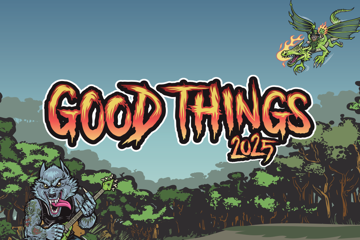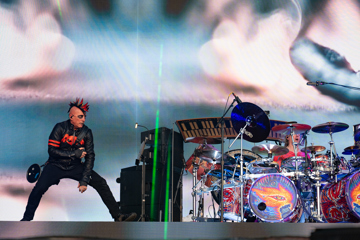Amanda Palmer On Her 'Hyper-personal, Accidentally Feminist, Extremely Direct' Record
Amanda Palmer wasn't really interested in doing "a hyper-personal, accidentally feminist, extremely direct record or book", but she has done exactly that with the release of album 'There Will Be No Intermission' and accompanying photography book. Photos by Kahn & Selesnick.

Can you share a bit of history behind this series of images at the beach?
With pleasure. When I hired Nicholas Kahn and Richard Selesnick, this photography/design duo from my neighbourhood in upstate New York, to shoot album artwork, I offered a really simple core concept for the photographs: theatrical, but real. This record deals head-on with the darkest subjects: death, abortion, cancer, miscarriage, grief. I didn't want to just shoot grim, grown-up portraits of myself, I wanted to shoot photographs that somehow captured the complexity of the feelings that the songs contain. We ended up shooting so much beautiful material that I decided to collect it in a book, with essays, instead of relegating it to vinyl and CD art - there just wasn't room there to fit the enormity of what we'd created. Those shots on the beach were a wonderful alchemy: that's a spot on Cape Cod, right near where I grew up, where Kahn and Selesnick have shot landscapes for years; they already had a deep working knowledge of the topography; the beaches, hills, and dunes.
 Photo by Kahn & Selesnick.
Photo by Kahn & Selesnick.
We did all of the art preparation at Richard's house and then loaded everything up into a car - the wardrobe, the fresh hydrangeas, the swords and skulls and antique dolls - and we went to several locations to build sets and improvise. I write about these moments in the book itself. There were a few really tearful moments. After going through three abortions over the course of my lifetime, then a natural childbirth with a 24-hour labor, then a recent miscarriage, I cannot tell you how joyful and cathartic it was to leap around on a beach, flinging a giant leaf-covered babydoll into the air, while Nicholas and Richard cheerfully shouted, "GOOD LORD, THAT LOOKS BEAUTIFUL, AMANDA! RUN, RUN! JUMP! NOW THROW THAT BABY INTO THE SEA!!" You can't look up that kind of therapy in the phone book.
 Photo by Kahn & Selesnick.
Photo by Kahn & Selesnick.
You regularly release music collections with some form of accompanying book. Outside of “extended liner notes”, what do you think this adds to your albums, particularly this one?
Don't miss a beat with our FREE daily newsletter
Absolutely. I have never been an "enigmatic" artist, and I prefer to overload my audience with optional context; they can pick and choose how deeply they want to travel into the backstories, but the backstories are always there, on offer, like a curational map-guide through the museum of my album. I always love being able to dig into the backstory of the works of my favourite artists; to me, it never lessens the emotional experience, it only amplifies.
You’ve said that “most of these songs were exercises in survival”, can the same be said of these portraits?
Well, not exactly. These photographs were incredibly therapeutic to create, and some of them even wound up becoming retroactively profound: like the beautiful pregnancy portrait that now lives as a rare document of the baby I lost. It felt like a very powerful choice to include that portrait in the book; because it sort of fixed the complexity of that experience in reality. I really was very pregnant, and I really did miscarry that baby, and it was all a part of my journey and reality. I am not going to hide and tuck those photos away into a box of locked grief, I am going to celebrate them for the moment they were, and for the strange, empowering gift that miscarriage gave me. But these photographs feel more like the supporting actors in the play of this album. The songs themselves, and writing them, and performing them for my community, were the true life rafts in my life while I was going through the storm of all these experiences.
 Photo by Kahn & Selesnick.
Photo by Kahn & Selesnick.
Right from the introduction, your focus is on the intersection of life and death. Is that something you tried to/did capture in the accompanying imagery?
Well, the more I experience both sides, the more I realise we're getting it terribly wrong, as a culture, on all counts. We're terrible at dealing with the realities of death, and how to discuss it, embrace it, and emotionally deal with it. Being around the immediate experience of death: holding my best friend while he died, walking in on another friend who died unexpectedly in his living room when I popped by for a surprise visit, going through a miscarriage on my own and dealing with the physical, visceral carnage... all of these things really gave me a kind of fearlessness and patience around the idea of death. It all started to feel like an honour to bear witness, instead of an experience to shy away from.
This was a process of approximately seven years. Is there a clear through line looking at the finished product now, or is it nothing so linear as that?
Yes, there's a through line I'm seeing, especially now that I'm working on the stage show and getting ready to take these songs out on tour. I wasn't really excited or interested in doing a hyper-personal, accidentally feminist, extremely direct record or book. That was never really the plan. But my personal life unfolded, along with abortion, and facing off with the world as a mother, right alongside the rise of Trump and the extreme right in America. And it made telling the truth feel essential. I think it's the sharpest, most effective political tool we wield right now, as women. The unadorned, shameless, naked truth of our experiences. And as these years went by, I became less and less afraid to just go for it, like a truth-seeking missile.
 Photo by Kahn & Selesnick.
Photo by Kahn & Selesnick.
Were the images all directly staged to match completed tracks?
No - we had groups of themes: the birth, death, rebirth, miscarriage, abortion, nature, liberation. By the time we got to the last shoot, though, there were some songs that didn't have images, like Voicemail For Jill, and I showed up with a box of old telephones, handed them to Nicholas and said: "Let's use these." The same was true of the trophies for Death Thing... that was a deliberate matching. Everything else was mix and matched.
This project, like many of your others, was supported by a cast of thousands. Does working directly with - and in a way, for - your audience have any bearing on your work?
Absolutely, in a way that I still find hard to truly comprehend. I've spent so many years of my career keeping the hustle in the back of my mind, "I'll have to release this, I'll have to sell this, I'll have to find everybody and convince them to listen to this," over and over and over again. The idea that I have such a massive group of unconditional supporters, the idea that I have 15,000 out there who've given me their credit cards numbers and really trust me to do what I think is best with my time, art and direction... it's like a wild dream that I half-expect to wake up from. I also know that I've worked very hard for this and that these are people I've already built a deeply trusting relationship with, both artistically and financially. I also am not surprised to find this, but my patrons are exceptionally intelligent, interesting, curious and critical thinkers. I listen to what they say because so many of them are so damn perceptive, and wise. It's a fantastic and supportive community, very compassionate and insightful, and reminiscent of the early internet.
 Photo by Kahn & Selesnick.
Photo by Kahn & Selesnick.
But what I mostly didn't expect was the effect this all had on my artistic voice. Having these patrons as a safety net of support has meant I am no longer second-guessing my own truth. I'm saying it, making it, doing it all, critics be damned, because at the end of the day, I know I've already found my audience, and they're interested in what I have to express whether or not the New York Times, Rolling Stone, or The Guardian ever give me an inch of ink. I've simply bypassed the entire mainstream media system - from the oldsters to the hipsters. There are no middlemen anymore. It's punk as fuck.
There Will Be No Intermission (Cooking Vinyl) is out 8 Mar.
An abridged version of this interview was originally published in the March issue of The Music. Pick up a copy of it on the street now or head here to read it online.






